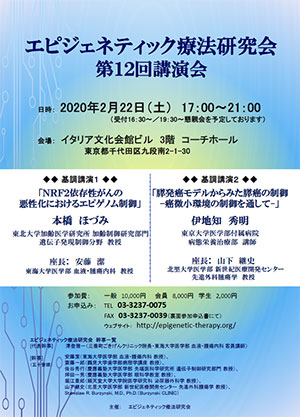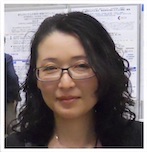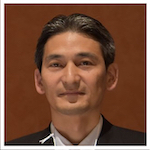第12回講演会

- 日程
- 2020年2月22日(土)
- 会場
- イタリア文化会館ビル 3階 コーチホール
- 来場者数
- 約30名
- 講演内容
-
-
基調講演1
「NRF2 依存性がんの悪性化におけるエピゲノム制御」
本橋 ほづみ
(東北大学加齢医学研究所 加齢制御研究部門 遺伝子発現制御分野 教授)座長:安藤 潔(東海大学医学部 血液・腫瘍内科 教授)
-

転写因子NRF2は、酸化ストレスや親電子性物質への曝露により一過性に安定化して、生体防御に関わる遺伝子群を活性化する。一方、ヒトの多くのがん細胞ではNRF2が恒常的に安定化し、がんの悪性化をもたらしている。こうしたNRF2依存性に悪性化を遂げているがん細胞(NRF2依存性がん)の治療標的を得るために、NRF2依存性がん細胞特異的なNRF2の標的遺伝子を探索した。その結果、NRF2依存性がん細胞には、ユニークなエンハンサーが形成されており、その制御下でNRF2依存性がん細胞特異的な標的遺伝子が活性化されていることがわかった。これらには腫瘍形成能を支える因子など、治療標的として有望なものが含まれていた。恒常的に活性化したNRF2は、生理的な一過性の活性化の場合とは異なる遺伝子発現制御プログラムを生み出していることが明らかになった。
-
基調講演2
「膵発癌モデルからみた膵癌の制御 -癌微小環境の制御を通して-」
伊地知 秀明(東京大学医学部付属病院 病態栄養治療部 講師座長:山下 継史(北里大学医学部 新世紀医療開発センター 先進外科腫瘍学 教授)
-

膵癌は、年々増加の一途を辿り、現在我が国の癌死の第4位となっている。その予後は全5年生存率が8-9%と、他の癌種に比べて圧倒的に不良な最難治癌であり、その病態解明とそれに基づく治療法の開発は大きな課題である。我々は、膵臓上皮特異的変異型Kras発現+TGF-βII型受容体ノックアウトにより、臨床の膵癌像をよく再現する膵発癌マウスモデルを樹立し報告した。本モデルは、間質の増生・著明な線維化を伴う腺癌を呈し、生後8週という短期間で癌死する。遺伝子改変膵発癌モデルの利点の一つは、従来の移植モデルと異なり、癌の微小環境が免疫系を含めてintactであることであり、特に膵癌のような間質の豊富な癌種では微小環境が病態に与える影響が大きく、治療薬の生体内での効果もそのような微小環境下で検討するべきと考えられる。
我々は、本モデルを通して、膵癌の微小環境を制御することにより膵癌を制御することができないかという観点で研究を行ってきた。膵癌の微小環境において腫瘍間質相互作用を阻害することが膵癌の予後改善に寄与する可能性がある。また、最近、膵癌微小環境におけるheterogeneityが注目を集めており、その理解が膵癌の制御に繋がる可能性がある。膵発癌マウスモデルの微小環境からみた膵癌の制御について述べてみたい。
-
The 12th symposium
- Speech
-
-
Special Lecture1
“Epigenetic regulation underlying malignant phenotypes of NRF2-addicted cancers”
Hozumi Motohashi, IDAC, Tohoku University -

While, a transcription factor NRF2 is transiently stabilized in response to oxidative stress and/or electrophilic stress, NRF2 is constitutively stabilized in many human cancer cells, driving their malignancy. Such cancer cells with persistent activation of NRF2 often fall in NRF2 addiction in terms of their proliferation, survival and therapeutic resistance. To obtain new therapeutic targets for such NRF2-addicted cancer cells, we explored NRF2 target genes unique to NRF2-addicted cancer cells. We found NRF2-dependent enhancer formation unique to NRF2-addicted cancer cells, which plays important roles in promoting malignant phenotypes. Intriguingly, constitutively stabilized NRF2 generates novel regulation of gene expression, which is distinct from that directed by transiently activated NRF2.
-
Special Lecture2
“Control of Pancreatic Cancer as Viewed from a Pancreatic Carcinogenesis Model ⎯ via Control of the Cancer Microenvironment”
Hideaki Ijichi, Department of Clinical Nutrition Therapy, The University of Tokyo Hospital -

The incidence of pancreatic cancer has been steadily increasing over the years, and this cancer currently ranks the fourth among all deaths from cancer in Japan. As for the prognosis of this disease, pancreatic cancer is overwhelmingly the most intractable malignancy as compared to other types of cancer, with an overall 5-year survival rate of as low as 8%-9%. Hence, elucidation of the pathophysiology of pancreatic cancer and development of appropriate therapy are critical challenges. We have established and reported a murine pancreatic carcinogenesis model by pancreatic epithelium-specific mutant Kras gene expression in combination with transforming growth factor-beta (TGF-β) II receptor knockout, and have demonstrated that the system accurately reproduces the clinical features of human pancreatic cancer. The murine model exhibits features of adenocarcinoma with stromal proliferation and pronounced fibrosis (desmoplasia), and dies from the cancer as early as at 8 weeks of age. One of the advantages of the genetically-engineered pancreatic carcinogenesis model is that the microenvironment of the cancer, including the immune systems, remains intact, unlike in the conventional transplant models. Particularly in cancer types that possess an abundance of stroma, such as pancreatic cancer, the microenvironment is considered to have a great impact on the pathophysiologic status of the cancer, underscoring the importance of evaluating the effects of therapeutic agents in vivo under the prevailing microenvironment.
We have been pursuing research, using the aforementioned murine model, from the viewpoint of seeking possible control of pancreatic cancer via control of the microenvironment. There is the possibility that inhibition of tumor-stroma interactions in such a cancer microenvironment may contribute to improvement of the prognosis of pancreatic cancer. Furthermore, heterogeneity of the microenvironment of pancreatic cancer has recently drawn attention, and a better understanding of this aspect may lead to the development of effective therapies for pancreatic cancer. I would like to state my view on the control of pancreatic cancer from the perspective of regulating the microenvironment in the murine pancreatic carcinogenesis model.
-







